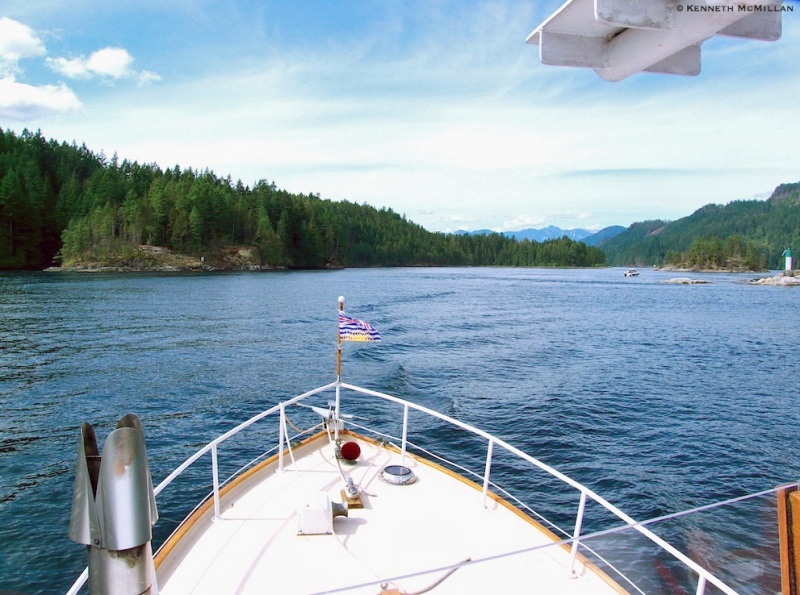Heading 4 miles (6.4 km ) north of the mouth of Narrows Inlet brings you to the Sechelt Rapids or as it is more commonly known, the Skookumchuck (Chinook for rough water) Narrows. Twice every day the tide rises and falls and the water in Sechelt, Narrows and Salmon Inlets either flows in or out of the narrow channel at the Sechelt Rapids. Eight small islets located in the channel make the passage even more restricted for both boats and water. At the narrowest point it is only about 400 feet (125 meters) wide and on a 9 foot tide change an estimated 200 billion gallons of water passes through the rapids creating dangerous standing waves and whirlpools. The water can attain speeds of up to 16 knots (18.4 mph, 37 km/h) and sometimes the difference between water levels on either side of the rapids can be 6.5 feet in height.
Needless to say, a great deal of caution is needed when traversing the rapids. It is necessary to know when slack tide (the brief period of calm between tide changes) is so that you can make it through the channel safely. Numerous boats have been lost at the Skookumchuck, the latest in 2009 when a tugboat pulling a barge through the rapids capsized.

Roland Point – a popular spot within the Park to watch the rapids
The rapids are encompassed by the 300 acre (123 hectare) Skookumchuck Narrows Provincial Park.
Our first experience going through the Skookumchuck was the day after we took command of our boat, Jazz Age. We picked up the boat in Gibsons, BC, 14 miles down the coast from Sechelt. We had obtained moorage at the Lighthouse Marina at the head of Sechelt Inlet so we needed to bring the boat up the coast 53 miles (83 km), pass through the Skookumchuck and go 18 miles (30 km) to the end of Sechelt Inlet. I had about 20 minutes training running the boat so it was somewhat daunting, especially with the Skookumchuck in the back of our minds. The trip up the coast was beautiful and other than the alternator falling off, uneventful. By the time we reached the Skookumchuck it was too late to go through that night so we found a dock and waited until the next morning.
The dock we tied up to was 3000 feet from the entrance to the rapids and we had a peaceful, calm evening watching the sun go down. In the middle of the night we woke to some very unusual noises. I got up and found the bay we were in was a swirling, boiling mass of water. The current was pushing the boat up against the dock and it was so powerful I couldn’t have moved the boat if I wanted to. It wasn’t causing any problems so we went back to bed. It was very impressive though.
At 9:00 am it looked fairly calm over at the rapids so we thought we’d bite the bullet. All was quite glassy calm until we got right into the entrance and then water developed the look of a light boil. We were just a bit too early but since our boat only travelled 7 knots (8 mph) at top speed and the tide was flowing in the right direction, I figured it was probably best just to carry on. We got through okay though often at a 45 degree angle off where the bow should have been pointing. Jazz Age was 36 feet long and heavy but the power of the water was very impressive.
We have been through the rapids several time since then and each time it has been dead calm.
For those adventurous spirits the rapids have become a popular spot for whitewater kayakers who surf the standing wave that forms off Roland Point. The rapids are also a very popular diving spot because of the abundance of sea life but obviously your timing has to be right!




